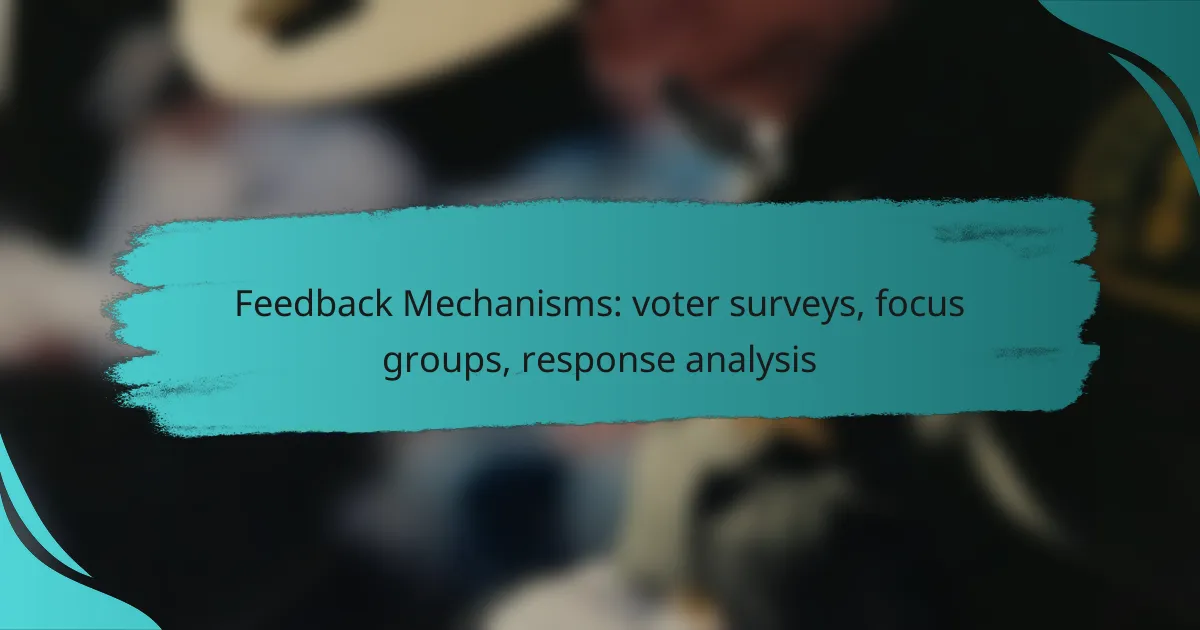Feedback mechanisms such as voter surveys and focus groups play a crucial role in understanding public opinion and enhancing political strategies. By systematically collecting and analyzing voter sentiments, organizations can tailor their approaches to better meet the needs of the electorate. Effective execution of these methods, including clear objectives and diverse participant recruitment, ensures valuable insights are gained for informed decision-making.
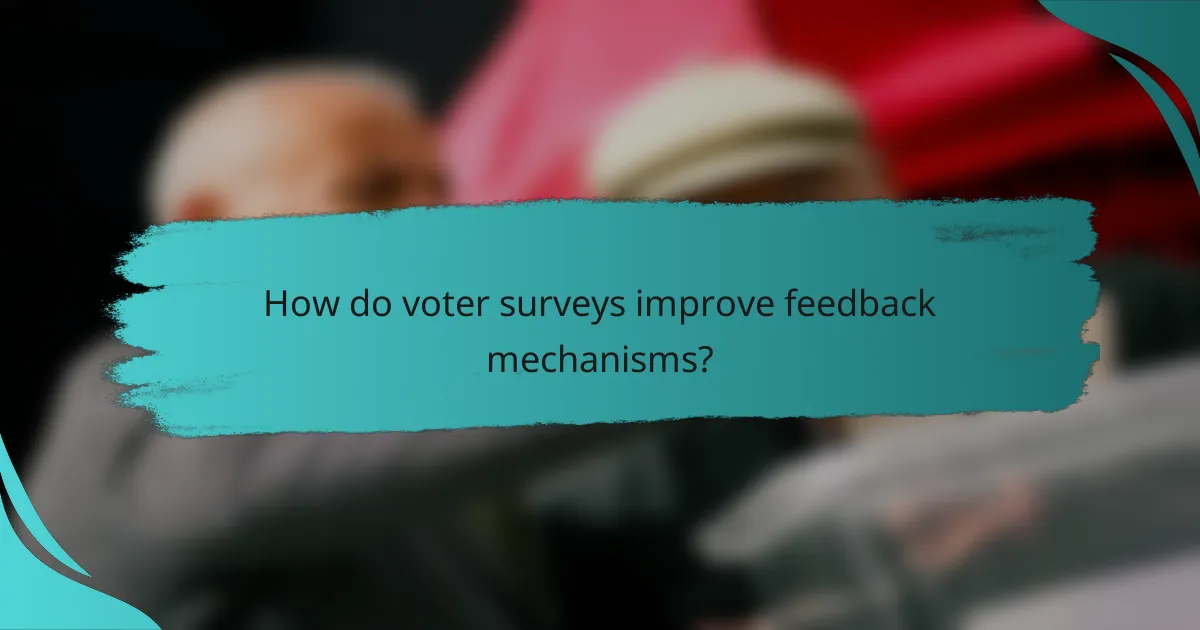
How do voter surveys improve feedback mechanisms?
Voter surveys enhance feedback mechanisms by systematically gathering opinions and preferences from the electorate. This data helps organizations and political entities understand voter sentiments, leading to more responsive and effective strategies.
Enhanced data collection
Voter surveys provide a structured way to collect data on public opinion, preferences, and concerns. By utilizing various methods such as online questionnaires, phone interviews, and in-person polling, organizations can gather a diverse range of insights. This comprehensive data collection allows for a more accurate representation of voter demographics and issues.
To maximize data collection effectiveness, surveys should be designed with clear, concise questions that avoid bias. Employing a mix of quantitative and qualitative questions can yield richer insights, helping to identify trends and specific areas of concern among different voter groups.
Informed decision-making
With the insights gained from voter surveys, decision-makers can craft policies and campaigns that resonate with the electorate. Analyzing survey results helps identify key issues that matter most to voters, enabling targeted messaging and resource allocation. This informed approach can lead to higher rates of voter satisfaction and support.
For optimal decision-making, it is crucial to regularly review and update survey methodologies to reflect changing voter sentiments. Engaging with focus groups can complement survey data, providing deeper context and understanding of the numbers.
Increased voter engagement
Voter surveys can significantly boost engagement by making voters feel heard and valued. When individuals see their opinions reflected in policy decisions or campaign strategies, they are more likely to participate in future elections and civic activities. This feedback loop fosters a sense of community and ownership among voters.
To encourage ongoing engagement, organizations should communicate survey findings back to the electorate. Sharing how feedback has influenced decisions can motivate voters to participate in future surveys, creating a continuous cycle of input and improvement.

What are the best practices for conducting focus groups?
Effective focus groups require strategic planning and execution to gather valuable insights. Best practices include defining clear objectives, recruiting a diverse range of participants, and utilizing skilled moderators to facilitate discussions.
Define clear objectives
Establishing clear objectives is crucial for focus groups to ensure that discussions remain relevant and productive. Objectives should specify what information is needed, such as understanding voter preferences or evaluating policy proposals.
Consider using the SMART criteria—Specific, Measurable, Achievable, Relevant, and Time-bound—to frame your objectives. For example, instead of a vague goal like “understand opinions,” aim for “gather feedback on three proposed policies within two hours.”
Recruit diverse participants
Diversity in participant recruitment enhances the richness of the discussions and ensures that various perspectives are represented. Aim for a mix of demographics, including age, gender, socioeconomic status, and political affiliation.
To achieve this, consider using targeted outreach strategies, such as partnering with community organizations or using social media platforms to attract a wide range of participants. A balanced group can lead to more comprehensive insights and reduce bias in the findings.
Utilize skilled moderators
Skilled moderators play a vital role in guiding focus group discussions and ensuring that all voices are heard. They should be trained to manage group dynamics, encourage participation, and keep conversations on track.
Effective moderators can adapt their questioning techniques based on participant responses, fostering a comfortable environment for open dialogue. Consider conducting a brief training session for moderators to review techniques for handling difficult situations or dominant participants.

How is response analysis conducted in the UK?
Response analysis in the UK involves systematically evaluating feedback from voters through various methods, including surveys and focus groups. This process helps organizations understand public opinion and improve decision-making based on the insights gathered.
Data coding and categorization
Data coding and categorization is the first step in response analysis, where raw feedback is organized into meaningful categories. This often involves assigning codes to open-ended responses, allowing for easier analysis of themes and trends. For instance, comments may be categorized into topics such as policy preferences, service satisfaction, or demographic insights.
Effective coding requires clear definitions and consistency to ensure that similar responses are grouped appropriately. Analysts typically use qualitative software tools to assist in this process, which can streamline the categorization and enhance accuracy.
Statistical analysis methods
Statistical analysis methods are employed to quantify the insights gained from the categorized data. Common techniques include descriptive statistics, which summarize the data, and inferential statistics, which help draw conclusions about the broader population based on sample data. For example, chi-square tests might be used to examine relationships between demographic factors and voting preferences.
Analysts often utilize software like SPSS or R for complex analyses, enabling them to handle large datasets efficiently. Understanding the appropriate statistical methods is crucial, as incorrect application can lead to misleading conclusions.
Reporting findings
Reporting findings involves presenting the analyzed data in a clear and accessible format for stakeholders. This typically includes visual aids such as graphs and charts to illustrate key trends and insights. Reports should highlight significant findings, such as voter satisfaction levels or the impact of specific policies on public opinion.
When preparing reports, it is essential to tailor the content to the audience, ensuring that technical jargon is minimized for broader understanding. Summarizing key points and providing actionable recommendations can enhance the utility of the report for decision-makers.
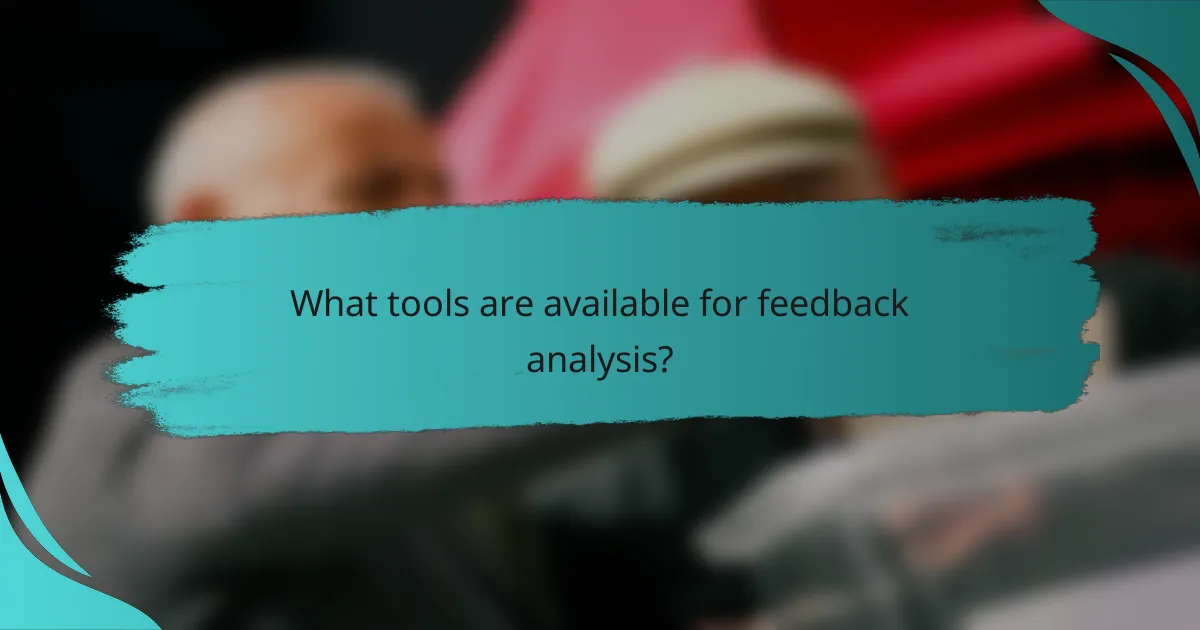
What tools are available for feedback analysis?
Several tools can effectively facilitate feedback analysis, including survey platforms, focus group software, and qualitative analysis programs. Each tool has unique features that cater to different aspects of gathering and interpreting voter feedback.
Qualtrics for surveys
Qualtrics is a robust platform designed for creating and distributing surveys. It offers customizable templates and advanced analytics, allowing users to gather insights from a wide audience efficiently. With features like branching logic and real-time reporting, it helps organizations understand voter sentiments and preferences.
When using Qualtrics, consider the target demographic and tailor questions accordingly to maximize response rates. A/B testing different survey formats can also yield insights into which styles resonate better with respondents.
FocusGroupIt for focus groups
FocusGroupIt provides an online platform for conducting focus groups, enabling real-time discussions and feedback collection. This tool is particularly useful for gathering qualitative insights, as it allows for in-depth conversations that reveal underlying motivations and opinions among voters.
To effectively utilize FocusGroupIt, ensure that the group composition reflects the diversity of the voter base. Prepare open-ended questions that encourage dialogue, and consider recording sessions for later analysis to capture nuances in responses.
NVivo for qualitative analysis
NVivo is a powerful software tool for qualitative data analysis, allowing users to organize and analyze open-ended feedback from surveys and focus groups. It supports various data types, including text, audio, and video, making it versatile for different research needs.
When using NVivo, start by coding responses to identify themes and patterns. Utilize its visualization tools to present findings clearly, which can aid in communicating insights to stakeholders effectively. Regularly back up your data to prevent loss during analysis.
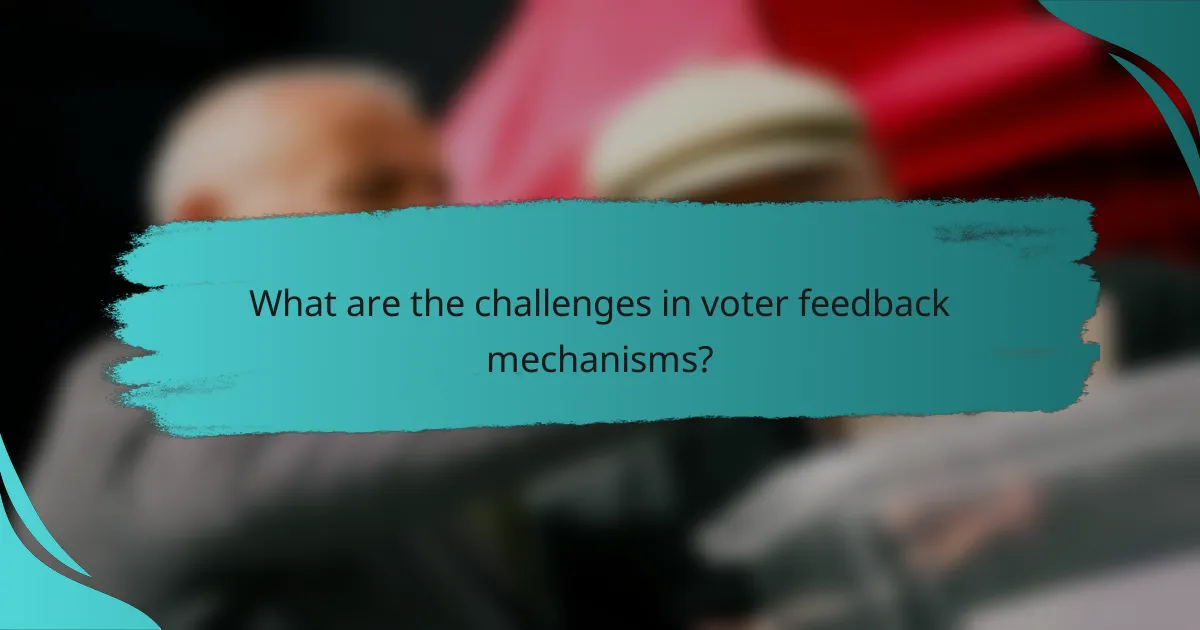
What are the challenges in voter feedback mechanisms?
Voter feedback mechanisms face several challenges that can hinder their effectiveness, including biases in responses, low participation rates, and concerns about data privacy. Addressing these issues is crucial for obtaining reliable and actionable insights from voters.
Bias in responses
Bias in responses can significantly skew the results of voter feedback mechanisms. This can occur due to leading questions, social desirability bias, or the demographics of respondents not representing the broader electorate. For instance, surveys conducted online may attract younger voters, while older demographics might be underrepresented.
To mitigate bias, it’s essential to design questions that are neutral and to ensure a diverse sample of participants. Employing mixed methods, such as combining surveys with focus groups, can also help balance out biases by providing qualitative insights alongside quantitative data.
Low participation rates
Low participation rates are a common challenge in gathering voter feedback, often resulting in unrepresentative data. Factors contributing to this issue include survey fatigue, lack of awareness, or perceived irrelevance of the feedback process. For example, a survey sent out shortly after an election may receive fewer responses as voters may feel their opinions are no longer timely.
To improve participation, consider offering incentives, simplifying the feedback process, and clearly communicating the importance of voter input. Engaging voters through multiple channels, such as social media and community events, can also enhance response rates.
Data privacy concerns
Data privacy concerns can deter voters from participating in feedback mechanisms. Many individuals worry about how their information will be used, stored, or shared, especially in an era of heightened awareness around data security. Ensuring transparency about data handling practices is vital for building trust.
To address privacy concerns, implement robust data protection measures and clearly outline how feedback will be anonymized and utilized. Providing voters with options to opt-out or to participate anonymously can also encourage more individuals to share their opinions without fear of repercussions.
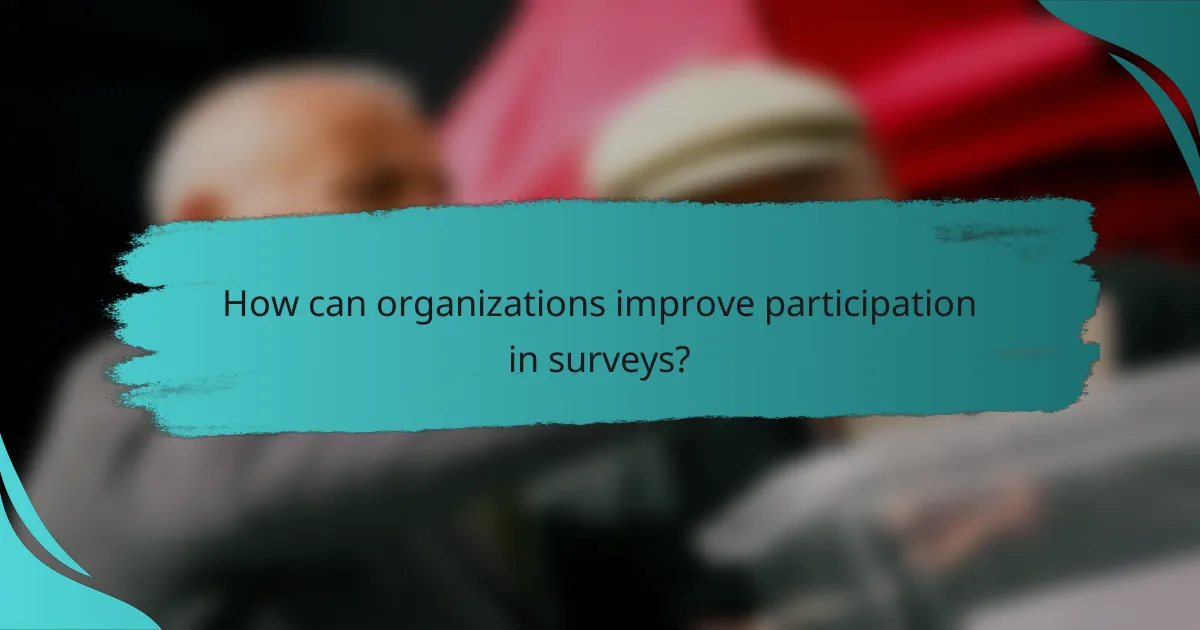
How can organizations improve participation in surveys?
Organizations can enhance participation in surveys by implementing effective strategies that engage respondents and convey the value of their input. Focusing on incentives and clear communication can significantly boost response rates.
Incentives for participation
Offering incentives is a proven method to increase survey participation. These can range from monetary rewards, such as gift cards or discounts, to non-monetary options like entry into a prize draw or exclusive access to content.
When selecting incentives, consider your target audience’s preferences. For instance, younger participants may respond better to digital rewards, while older demographics might appreciate tangible gifts. A well-structured incentive program can lead to higher engagement and completion rates.
Clear communication of purpose
Clearly communicating the purpose of the survey is essential for encouraging participation. Respondents are more likely to engage when they understand how their feedback will be used and the impact it may have on decisions or improvements.
Use straightforward language and highlight the importance of the survey in your outreach efforts. For example, stating that feedback will directly influence community programs can motivate individuals to participate. Additionally, providing estimated completion times can help set expectations and reduce drop-off rates.
